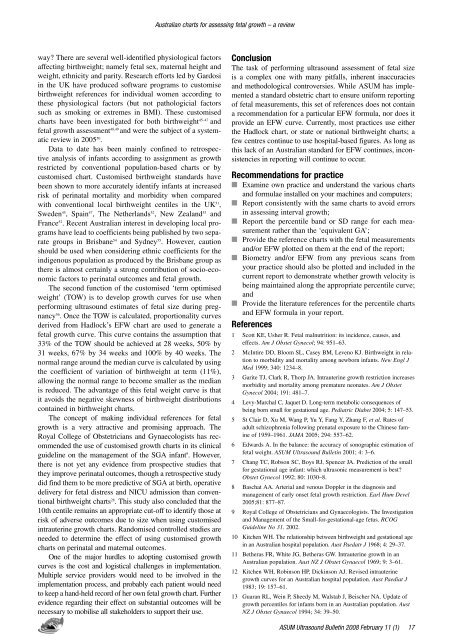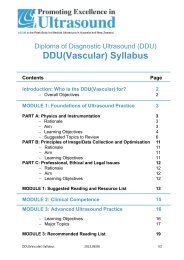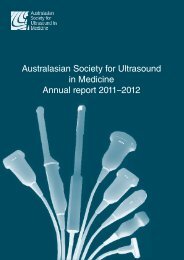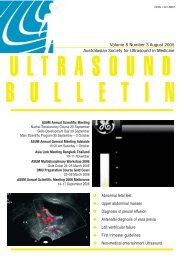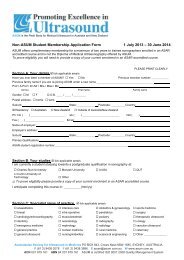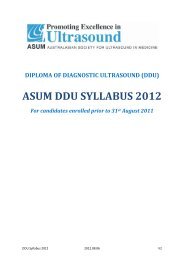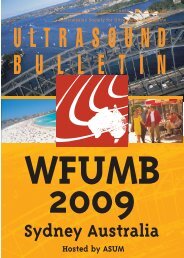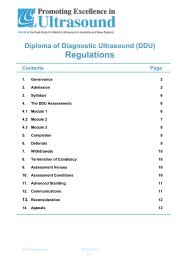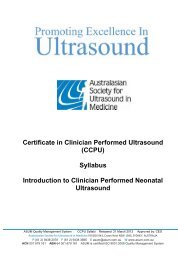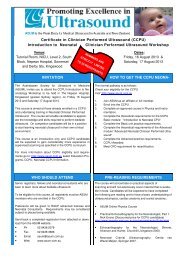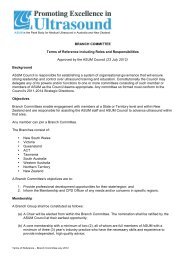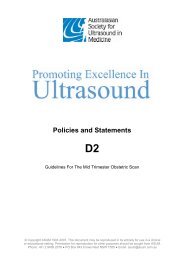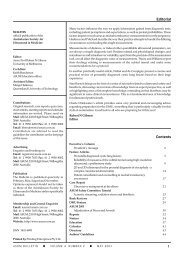Volume 11 Issue 1 (February) - Australasian Society for Ultrasound ...
Volume 11 Issue 1 (February) - Australasian Society for Ultrasound ...
Volume 11 Issue 1 (February) - Australasian Society for Ultrasound ...
You also want an ePaper? Increase the reach of your titles
YUMPU automatically turns print PDFs into web optimized ePapers that Google loves.
Australian charts <strong>for</strong> assessing fetal growth – a review<br />
way? There are several well-identified physiological factors<br />
affecting birthweight; namely fetal sex, maternal height and<br />
weight, ethnicity and parity. Research ef<strong>for</strong>ts led by Gardosi<br />
in the UK have produced software programs to customise<br />
birthweight references <strong>for</strong> individual women according to<br />
these physiological factors (but not pathologicial factors<br />
such as smoking or extremes in BMI). These customised<br />
charts have been investigated <strong>for</strong> both birthweight 45–47 and<br />
fetal growth assessment 48,49 and were the subject of a systematic<br />
review in 2005 50 .<br />
Data to date has been mainly confined to retrospective<br />
analysis of infants according to assignment as growth<br />
restricted by conventional population-based charts or by<br />
customised chart. Customised birthweight standards have<br />
been shown to more accurately identify infants at increased<br />
risk of perinatal mortality and morbidity when compared<br />
with conventional local birthweight centiles in the UK 51 ,<br />
Sweden 45 , Spain 47 , The Netherlands 52 , New Zealand 53 and<br />
France 52 . Recent Australian interest in developing local programs<br />
have lead to coefficients being published by two separate<br />
groups in Brisbane 54 and Sydney 55 . However, caution<br />
should be used when considering ethnic coefficients <strong>for</strong> the<br />
indigenous population as produced by the Brisbane group as<br />
there is almost certainly a strong contribution of socio-economic<br />
factors to perinatal outcomes and fetal growth.<br />
The second function of the customised ‘term optimised<br />
weight’ (TOW) is to develop growth curves <strong>for</strong> use when<br />
per<strong>for</strong>ming ultrasound estimates of fetal size during pregnancy<br />
56 . Once the TOW is calculated, proportionality curves<br />
derived from Hadlock’s EFW chart are used to generate a<br />
fetal growth curve. This curve contains the assumption that<br />
33% of the TOW should be achieved at 28 weeks, 50% by<br />
31 weeks, 67% by 34 weeks and 100% by 40 weeks. The<br />
normal range around the median curve is calculated by using<br />
the coefficient of variation of birthweight at term (<strong>11</strong>%),<br />
allowing the normal range to become smaller as the median<br />
is reduced. The advantage of this fetal weight curve is that<br />
it avoids the negative skewness of birthweight distributions<br />
contained in birthweight charts.<br />
The concept of making individual references <strong>for</strong> fetal<br />
growth is a very attractive and promising approach. The<br />
Royal College of Obstetricians and Gynaecologists has recommended<br />
the use of customised growth charts in its clinical<br />
guideline on the management of the SGA infant 9 . However,<br />
there is not yet any evidence from prospective studies that<br />
they improve perinatal outcomes, though a retrospective study<br />
did find them to be more predictive of SGA at birth, operative<br />
delivery <strong>for</strong> fetal distress and NICU admission than conventional<br />
birthweight charts 28 . This study also concluded that the<br />
10th centile remains an appropriate cut-off to identify those at<br />
risk of adverse outcomes due to size when using customised<br />
intrauterine growth charts. Randomised controlled studies are<br />
needed to determine the effect of using customised growth<br />
charts on perinatal and maternal outcomes.<br />
One of the major hurdles to adopting customised growth<br />
curves is the cost and logistical challenges in implementation.<br />
Multiple service providers would need to be involved in the<br />
implementation process, and probably each patient would need<br />
to keep a hand-held record of her own fetal growth chart. Further<br />
evidence regarding their effect on substantial outcomes will be<br />
necessary to mobilise all stakeholders to support their use.<br />
Conclusion<br />
The task of per<strong>for</strong>ming ultrasound assessment of fetal size<br />
is a complex one with many pitfalls, inherent inaccuracies<br />
and methodological controversies. While ASUM has implemented<br />
a standard obstetric chart to ensure uni<strong>for</strong>m reporting<br />
of fetal measurements, this set of references does not contain<br />
a recommendation <strong>for</strong> a particular EFW <strong>for</strong>mula, nor does it<br />
provide an EFW curve. Currently, most practices use either<br />
the Hadlock chart, or state or national birthweight charts; a<br />
few centres continue to use hospital-based figures. As long as<br />
this lack of an Australian standard <strong>for</strong> EFW continues, inconsistencies<br />
in reporting will continue to occur.<br />
Recommendations <strong>for</strong> practice<br />
n Examine own practice and understand the various charts<br />
and <strong>for</strong>mulae installed on your machines and computers;<br />
n Report consistently with the same charts to avoid errors<br />
in assessing interval growth;<br />
n Report the percentile band or SD range <strong>for</strong> each measurement<br />
rather than the ‘equivalent GA’;<br />
n Provide the reference charts with the fetal measurements<br />
and/or EFW plotted on them at the end of the report;<br />
n Biometry and/or EFW from any previous scans from<br />
your practice should also be plotted and included in the<br />
current report to demonstrate whether growth velocity is<br />
being maintained along the appropriate percentile curve;<br />
and<br />
n Provide the literature references <strong>for</strong> the percentile charts<br />
and EFW <strong>for</strong>mula in your report.<br />
References<br />
1 Scott KE, Usher R. Fetal malnutrition: its incidence, causes, and<br />
effects. Am J Obstet Gynecol; 94: 951–63.<br />
2 McIntire DD, Bloom SL, Casey BM, Leveno KJ. Birthweight in relation<br />
to morbidity and mortality among newborn infants. New Engl J<br />
Med 1999; 340: 1234–8.<br />
3 Garite TJ, Clark R, Thorp JA. Intrauterine growth restriction increases<br />
morbidity and mortality among premature neonates. Am J Obstet<br />
Gynecol 2004; 191: 481–7.<br />
4 Levy-Marchal C, Jaquet D. Long-term metabolic consequences of<br />
being born small <strong>for</strong> gestational age. Pediatric Diabet 2004; 5: 147–53.<br />
5 St Clair D, Xu M, Wang P, Yu Y, Fang Y, Zhang F, et al. Rates of<br />
adult schizophrenia following prenatal exposure to the Chinese famine<br />
of 1959–1961. JAMA 2005; 294: 557–62.<br />
6 Edwards A. In the balance: the accuracy of sonographic estimation of<br />
fetal weight. ASUM <strong>Ultrasound</strong> Bulletin 2001; 4: 3–6.<br />
7 Chang TC, Robson SC, Boys RJ, Spencer JA. Prediction of the small<br />
<strong>for</strong> gestational age infant: which ultrasonic measurement is best?<br />
Obstet Gynecol 1992; 80: 1030–8.<br />
8 Baschat AA. Arterial and venous Doppler in the diagnosis and<br />
management of early onset fetal growth restriction. Earl Hum Devel<br />
2005;81: 877–87.<br />
9 Royal College of Obstetricians and Gynaecologists. The Investigation<br />
and Management of the Small-<strong>for</strong>-gestational-age fetus. RCOG<br />
Guideline No 31. 2002.<br />
10 Kitchen WH. The relationship between birthweight and gestational age<br />
in an Australian hospital population. Aust Paedatr J 1968; 4: 29–37.<br />
<strong>11</strong> Betheras FR, White JG, Betheras GW. Intrauterine growth in an<br />
Australian population. Aust NZ J Obstet Gynaecol 1969; 9: 3–61.<br />
12 Kitchen WH, Robinson HP, Dickinson AJ. Revised intrauterine<br />
growth curves <strong>for</strong> an Australian hospital population. Aust Paediat J<br />
1983; 19: 157–61.<br />
13 Guaran RL, Wein P, Sheedy M, Walstab J, Beischer NA. Update of<br />
growth percentiles <strong>for</strong> infants born in an Australian population. Aust<br />
NZ J Obstet Gynaecol 1994; 34: 39–50.<br />
ASUM <strong>Ultrasound</strong> Bulletin 2008 <strong>February</strong> <strong>11</strong> (1)


